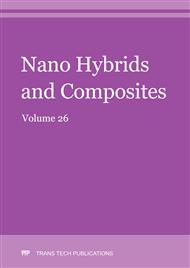[1]
A. Aziz, H. Nguyen, Two dimensional performance of convecting-radiating fins of different profile shapes, Waerme Stoffuebertrag, 28: 481-487, (1993).
DOI: 10.1007/bf01539679
Google Scholar
[2]
A. Aziz, J.R.J. Lopez, Convection-radiation from a continuously moving, variable thermal conductivity sheet or rod undergoing thermal processing, Int J Thermal Science, 50: 1523-1531, (2013).
DOI: 10.1016/j.ijthermalsci.2011.03.014
Google Scholar
[3]
B. Kundu, K. Lee, A proper analytical analysis of annular step porous fins for determining maximum heat transfer, Energy Conversion and Management, 110: 469-480, (2016).
DOI: 10.1016/j.enconman.2015.09.037
Google Scholar
[4]
P.L. Ndlovu, R,J, Moitsheki, Application of the two-dimensional differential transform method to heat conduction problem for heat transfer in longitudinal rectangular and convex parabolic fins, Comm Nonlinear Science Num Sim, 18: 2689-2698, (2013).
DOI: 10.1016/j.cnsns.2013.02.019
Google Scholar
[5]
D.W. Mueller Jr, H.I. Abu-Mulaweh, Prediction of the temperature in a fin cooled by natural convection and radiation, Applied Thermal Engineering, 26: 1662-1668, (2016).
DOI: 10.1016/j.applthermaleng.2005.11.014
Google Scholar
[6]
P. Malekzadeh, H. Rahideh, G. Karami, Optimization of convective-radiative fins by using differential quadrature element method, Energy Conversion and Management, 47: 1505-1514, 2007.[7] P. Malekzadeh, H. Rahideh, A.R. Setoodeh, Optimization of non-symmetric convective-radiative annular fins by differential quadrature method, Energy Conversion and Management, 48: 1671- 1677, (2007).
DOI: 10.1016/j.enconman.2006.11.002
Google Scholar
[8]
P. Razelos, X. Kakatsios, Optimum dimensions of convecting-radiating fins: Part I - longitudinal fins, Applied Thermal Engineering, 20: 1161-1192, (2000).
DOI: 10.1016/s1359-4311(99)00089-7
Google Scholar
[9]
A. Aziz, F. Khani, Convection-radiation from a continuously moving fin of a variable thermal conductivity, Franklin Institute, 348: 640-651, (2011).
DOI: 10.1016/j.jfranklin.2011.01.008
Google Scholar
[10]
A.M. Torabi, Q. Zhang, Analytical solution for evaluating the thermal performance and efficiency of convective-radiative straight fins with various profiles and considering all nonlinearities, Energy Conversion and Management, 66: 199-210, (2013).
DOI: 10.1016/j.enconman.2012.10.015
Google Scholar
[11]
Y. Sun, J. Ma, B. Li, Z. Guo, Predication of nonlinear heat transfer in a convective-radiative fin with temperature-dependent properties by the collocation spectral method, Numerical Heat Transfer Part B, 69(1): 68-83, (2016).
DOI: 10.1080/10407782.2015.1081043
Google Scholar
[12]
B. Kundu, S. Wongwises, A decomposition analysis on convective-radiating rectangular plate fins for variable thermal conductivity and heat transfer coefficient, Franklin Institute, 349, 966- 984, (2012).
DOI: 10.1016/j.jfranklin.2011.12.002
Google Scholar
[13]
I.L. Animasaun, Effects of thermophoresis, variable viscosity and thermal conductivity on free convective heat and mass transfer on non-darcian MHD dissipative Casson fluid flow with suction and nth order of chemical reaction, Journal of the Nigerian Mathematical Society, 35: 1-17, (2016).
DOI: 10.1016/j.jnnms.2015.06.004
Google Scholar
[14]
I.L. Animasaun, E.A. Adebile, A.I. Fagbade, Casson fluid flow with variable thermo-physical property along exponentially stretching sheet with suction and exponentially decaying internal heat generation using the homotopy analysis method, Journal of the Nigerian Mathematical Society, 34: 11-31, (2015).
DOI: 10.1016/j.jnnms.2015.02.001
Google Scholar
[15]
I.L. Animasaun, Casson fluid flow with variable viscosity and thermal conductivity along exponentially stretching sheet embedded in a thermally stratified medium with exponentially heat generation, Journal of Heat and Mass Transfer Research, 2(2): 63-78, (2015).
DOI: 10.1016/j.jnnms.2015.02.001
Google Scholar
[16]
O.K. Koriko, K.S. Adegbie, A.J. Omawaye, I.L. Animasaun, Boundary layer analysis of upper convected Maxwell fluid flow with variable thermo-physical properties over a melting thermally stratified surface, FUTA Journal of Research in Sciences, 12(2): 287-298, (2016).
DOI: 10.4236/am.2015.68129
Google Scholar
[17]
A.J. Omowaye, I.L. Animasaun, Upper-convected Maxwell fluid flow with variable thermophysical properties over a melting surface situated in hot environment subject to thermal stratification, Journal of Applied Fluid Mechanics, 9(4): 1777-1790, (2016).
DOI: 10.18869/acadpub.jafm.68.235.24939
Google Scholar
[18]
A.S. Dogonchi, D.D. Ganji, Convection-radiation heat transfer study of moving fin with temperature-dependent thermal conductivity, heat transfer coefficient and heat generation, Applied Thermal Engineering, 103: 705-712, (2016).
DOI: 10.1016/j.applthermaleng.2016.04.121
Google Scholar
[19]
S.A. Atouei, K. Hosseinzadeh, M. Hatamic, et. al., Heat transfer study on convective-radiative semi-spherical fins with temperature-dependent properties and heat generation using efficient computational methods, Applied Thermal Engineering, 89: 299-305, (2015).
DOI: 10.1016/j.applthermaleng.2015.05.084
Google Scholar
[20]
M. Torabi, H. Yaghoobi, A. Aziz, Analytical solution for convective-radiative continuously moving fin with temperature-dependent thermal conductivity, Int J of Thermophysics, 33: 924-941, 2012.[21] A. Moradi, A.P.M. Fallah, T. Hayat, O.M. Aldossary, On Solution of Natural Convection and Radiation Heat Transfer Problem in a Moving Porous Fin, Arabian J Science and Engineering, 39: 1303-1312, (2014).
DOI: 10.1007/s10765-012-1179-z
Google Scholar
[22]
M. Turkyilmazoglu, Heat transfer from moving exponential fins exposed to heat generation, Int J of Heat and Mass Transfer, 116: 346-351, (2018).
DOI: 10.1016/j.ijheatmasstransfer.2017.08.091
Google Scholar
[23]
A.D. Kraus, A. Aziz, J. Welty, Extended Surface Heat Transfer, Wiley, New York, (2001).
Google Scholar
[24]
Q.D. Kern, D.A. Kraus, Extended Surface Heat Transfer, McGraw-Hill, New York, (1992).
Google Scholar
[25]
J.K. Zhou, Differential Transform Method and Its Applications for Electric Circuits, Huazhong Univ Press, Wuhan, China, (1986).
Google Scholar
[26]
C.K. Chen, C.K. Ho, Solving partial differential equations by two-dimensional differential transform method, App Math and Computers, 106: 171-179, (1999).
DOI: 10.1016/s0096-3003(98)10115-7
Google Scholar
[27]
F. Kangalgil, F. Ayaz, Solitary wave solutions for the KdV and mKdV equations by differential transform method. Chaos, Solitons and Fractals, 41(1): 464-472, (2009).
DOI: 10.1016/j.chaos.2008.02.009
Google Scholar
[28]
F. Ayaz, On the two-dimensional differential transform method, Comp and App Mathematics, 143: 361-374, (2003).
Google Scholar
[29]
A.S.V.R. Kanth, K. Aruna, Differential transform method for solving linear and nonlinear systems of partial differential equations. Physics Letters, 372: 6896-6898, (2008).
DOI: 10.1016/j.physleta.2008.10.008
Google Scholar
[30]
H.C. Ünal, An analytical study of boiling heat transfer from a fin, Int J of Heat and Mass Transfer, 31: 1483-1496, (1988).
Google Scholar
[31]
P. Kanti Roy, A. Mallick, H. Mondal, P. Sibanda, A Modified Decomposition Solution of Triangular Moving Fin with Multiple Variable Thermal Properties, Arabian J Science and Engineering, 43(30): 1485-1497, (2017).
DOI: 10.1007/s13369-017-2983-3
Google Scholar


